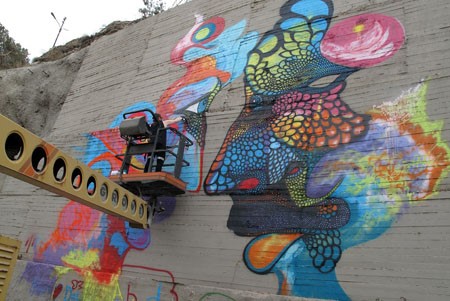Siel Devos, London, England, SSH Blog Correspondent

Last month I wrote about how I experienced harassment in Amman, and I ended my post by wondering how we can address this issue and bring a change to the mentality of Arab men and boys towards women. You can imagine my excitement when I came across a project called Women on Walls that focuses on women’s empowerment through graffiti and gives artists a chance to express themselves through street art.
Women on Walls (WOW) was founded by Angie Balata and Mia Grondahl, who recorded the contributions made by graffiti artists to the 25 January Revolution in Egypt in her book “The Revolution’s Graffiti”. After noticing that of the 17.000 street art photographed in the book only 253 featured women, they decided to take action and came up with the Women on Walls project to draw attention to women’s rights issues through street art. Thanks to their graffiti project in the Bourse area in Cairo, WOW gained more exposure, which eventually led them to collaborate with women’s and anti-harassment organisations like HarassMap and Uprising of Women in the Arab World in 2014. WOW is currently expanding through the region, starting with a street arts festival in Jordan, where 25 women artists from Palestine, Jordan and Lebanon contribute works to the wall to spark the conversation on women’s issues.
Laila Ajjawi, one of the artists participating in the WOW festival in Amman, says she wants to bring a message to men who still look at girls as objects instead of full-fledged human beings with intellectual depth. Research has shown that 80 percent of Jordanian women have experienced street harassment, and 99.3 percent of Egyptian women have reported being sexually harassed, so it’s clear that street harassment is still a problematic issue in the region. This is the reason why Ajjawi choose to focus on street harassment in line with the Women on Walls festival theme “Stories from Fear to Freedom”. She finds that street art is the perfect way to address the issue of street harassment because it reaches a much wider audience. “It challenges harassers in their domain: the streets. This kind of art doesn’t just decorate cement walls; it forces a conversation. “It catches the eye,” says Ajjawi. “But it’s not confrontational.”
Women are often fearful of speaking out against harassment, but Ajjawi hopes that her art may stand in for those who have been silenced into submission.
“If a women is silent, it’s because society compels her to be silent,” says Ajjawi.
The Amman festival combined the Women on Walls project with Baladak, launched by Al Balad Theatre in 2013, who aim to enhance the sense of citizenship through street art. In addition to revealing the street art gallery, the festival also included discussions, lectures and meetings initiated by local organisations to “raise awareness on women’s issues in Jordan and the Arab world, and create an inspirational space for artists to express their opinions,” says Al Balad Theatre Programme manager Lubna Al-Juqqa. The aim is to change the stereotypical image of women that is presented by the media as “just a pretty face”.
A great initiative if you ask me – I hope Women on Walls will expand throughout the region and most importantly, continue to raise awareness of street harassment and women’s issues in the Middle East.
Siel is a master’s student in Middle Eastern studies with a major in contemporary Islam at SOAS University in London. Find her on twitter and instagram under @mademoisielle.
